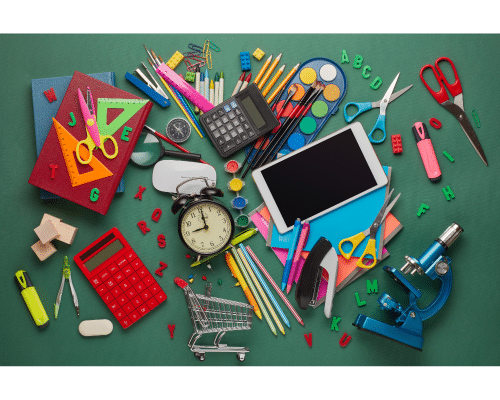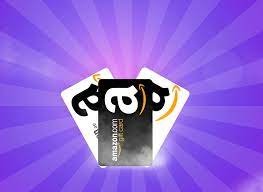Budget-Friendly Back-To-School Shopping Hacks Revealed

The start of the school year often brings with it a long list of required supplies for parents.
Filling that list can drain your wallet faster than you’d like. But here’s the good news:
With smart planning and some savvy shopping, these Back-To-School Shopping Hacks will help keep costs under control.
The Financial Impact of Back-to-School Shopping
Back-to-school shopping can feel like a daunting financial hurdle for many families. The pressure it puts on budgets is substantial, especially in today’s climate of high inflation.
This year’s outlay for back-to-school buying is anticipated to be similar to last year’s record $37 billion, in accordance with the National Retail Federation (NRF). This hefty sum reflects an average spend per family with children in elementary through high school at around $864. This includes essential items such as textbooks and uniforms but also covers additional expenses like electronics and extracurricular activity fees.
Families’ Spending Habits
The annual NRF survey revealing what families are prioritizing when it comes to their school shopping lists has noted a change. Electronics have taken center stage, with tablets, laptops, and calculators among the top-purchased items; however, other necessities like clothing still account for a considerable portion of each family’s budget.
Nearly every child will need some form of electronic device, be it for research or online learning, which further drives up costs significantly compared to decades past when such gadgets were not required within education settings.
Inflation Adds Extra Pressure
Inflation, which continues unabated amidst global supply chain disruptions caused by recent events, including trade disputes and pandemic-related issues, adds fuel to this fire. As consumer goods continue getting pricier, largely because manufacturers are passing increased production costs onto consumers, it becomes increasingly difficult for families trying to manage their finances effectively while ensuring they’re able to provide all necessary materials needed during the new academic year without breaking the bank too much.
Rising Costs: A National Concern
Given escalating concerns regarding ever-increasing educational expenses across the nation, the issue isn’t just confined to the individual household level anymore; indeed, it is a matter of national concern warranting attention from policymakers alike who must find ways to alleviate the pressures faced by ordinary Americans striving to provide the best possible opportunities for the next generation despite mounting economic odds against them.
In conclusion, successfully navigating the treacherous financial waters associated with back-to-school shopping entails employing smart strategies coupled with careful planning well in advance of the season, starting earnestly in order to avoid unnecessary stress and anxiety later down the line, whether you’re a parent or a student yourself embarking on the journey of higher education and beyond.
Key Takeaway:
Back-to-school shopping, with its hefty price tag averaging $864 per family, can be a significant financial strain. With inflation driving up costs and electronics becoming essential school supplies, smart strategies and careful planning are crucial to navigate these choppy financial waters without sinking your budget.
Practical Back-To-School Shopping Hacks
The annual back-to-school shopping period can be a monetary strain for many households. However, with the right approach and some clever strategies, it’s possible to secure all of your child’s school supplies without draining your wallet.
Reusing and Recycling Old Supplies
A simple yet effective strategy is to reuse or recycle old supplies from previous years. Before you embark on this year’s total back-to-school spending spree, take stock of what items are still usable at home. You may find that last year’s pens are still in working order or that your notebooks have plenty of blank pages left.
This method doesn’t just keep dollars in your pocket; it helps reduce environmental impact too.
Investing in Durable Gear
Beyond repurposing older gear where feasible, consider investing more upfront in durable goods like backpacks and lunch boxes. While these might come with higher price tags initially, their lifespan often makes them worth every penny over time.
A quality backpack that lasts several years will invariably end up costing less than replacing an inexpensive one annually due to wear and tear. The same principle applies when choosing between reusable lunch containers versus disposable options, though they might seem pricey compared to plastic baggies, they’ll pay off quickly once you factor in how much you would spend throughout the entire school year.
Online Shopping Advantages
When done strategically, online shopping provides significant savings during the back-to-school season through coupon codes and cashback offers available on various websites, such as Rakuten. Furthermore, retailers frequently send promotional emails featuring exclusive discounts that aren’t always available in-store. Free shipping deals make it even easier and sometimes cheaper than going out and physically hunting down sales across different locations. Before committing to a purchase, be sure to compare prices across different websites in order to secure the best deal on each item.
Prioritizing Big-Ticket Items
Focusing your efforts on finding deals on electronics can lead to substantial savings, given the high costs associated with tech products like laptops and tablets. If you find a great deal or significant discount, it alone can drastically reduce your total expenditure, thereby keeping the overall cost under control. Also, remember that an important part of the process involves making fewer full-price purchases as well.
Utilizing Sales Fliers
Another practical hack includes comparing your personal shopping list against store sales fliers. This allows you to identify potential opportunities to score better deals on particular items. This is especially useful for planning ahead and purchasing non-perishable supplies in bulk during sale periods rather than waiting until the start of the academic term when prices are likely higher. Always remember the cardinal rule of a savvy shopper: never make impulse buys. Instead, taking the time to research, compare, and evaluate your choices ensures maximum bang for your buck. Ultimately, the goal isn’t simply to buy the cheapest option, but to invest wisely in products that deliver the best long-term value for your family’s financial health and student success.
Key Takeaway:
Back-to-school shopping doesn’t have to break the bank. By reusing old supplies, investing in durable items, shopping smart online, focusing on big-ticket discounts, and utilizing sales fliers for comparison against your list, you can ensure maximum savings without compromising on quality or student success.
Sustainable Alternatives for School Supplies
As we get ready to equip our children for their return to school, it’s important to think about the economic and ecological effects of buying supplies. It may be surprising, but choosing sustainable alternatives can help save money while also reducing waste.
Reusable Lunch Containers: A Greener Choice
A prime example of this strategy is investing in reusable lunch containers instead of disposable bags or boxes. Not only do these eco-friendly options minimize waste, but they often keep food fresher longer than their disposable counterparts.
- Durable materials ensure long-term use.
- Ease of cleaning saves parents’ precious time every day.
- Their stylish designs appeal to children, making them more likely to bring home leftovers rather than throw away uneaten portions at school—another win for sustainability.
Ink Your Thoughts with Refillable Pens and Pencils
Moving on from lunches, let’s look at stationery.
Refillable pens and pencils are a fantastic option when considering sustainable school supplies.
Rather than tossing out the entire pen once the ink runs dry or buying a new set of pencils because your child keeps misplacing theirs, investing in refillable writing tools helps both save resources and reduce plastic consumption over the course of the academic year.
Notebooks From Recycled Paper
Paper production has one of the highest impacts on deforestation worldwide, a problem that could be alleviated by opting for frequently recycled materials.
If traditional notebooks are the preferred method of note-taking, there are plenty of brands offering eco-friendly alternatives made from post-consumer paper. These not only serve the purpose effectively, like regular ones, but also contribute significantly towards preserving the environment.

Durability Over Cheap Thrills: Backpacks and Binders That Last
We’ve covered small-ticket items like lunchboxes and stationery, now let’s move onto larger essentials: backpacks and binders. While it may be tempting to buy the cheapest available options, you may find yourself replacing these annually due to poor quality, resulting in repeated costs and contributing to landfill waste.
Instead, purchasing a heavy-duty backpack and binder, even though the initial investment may be a bit higher, proves to be an economical choice in the long run. Remember, the goal isn’t necessarily to spend less at the outset, but rather to make smart decisions that will lead to overall savings down the line while also helping to protect the planet.
Key Takeaway:
Go green to save some green. Opt for sustainable school supplies like reusable lunch containers, refillable pens and pencils, notebooks made from recycled paper, and durable backpacks. These eco-friendly choices not only reduce waste but also prove economical in the long run.
DIY Personalization
The thrill of back-to-school shopping often lies in the selection of new supplies. Kids love to choose items that reflect their personal tastes, from vibrant notebooks to pencils adorned with favorite characters. However, these jazzier school supplies usually come at a higher cost.
A clever and fun savings hack for parents is DIY personalization – buying basic or plain school supplies and allowing your children to personalize them themselves. This not only saves money but also sparks creativity while making each item uniquely theirs.
Purchasing Plain White Binders
Binder is one such essential element where this strategy can be effectively applied. Instead of spending extra on designer binders featuring popular movie characters or flashy designs, opt for simple white binders, which are generally more affordable and serve as an empty canvas ready for customization.
Your child could decorate their binder using inexpensive stickers related to things they adore—superheroes, animals, stars; the possibilities are endless. Colored markers offer another way for artistic expression on these blank surfaces, too.
Making Use Of Inexpensive Stickers
Inexpensive stickers aren’t just great for decorating binders; they’re versatile enough to add personality to almost any school supply item, including pencil cases, lunch boxes, and even water bottles. There’s no limit. You can find packs of assorted stickers online at very reasonable prices, catering to diverse interests among kids.
Digital Tools For Creative Expression
If your child is tech-savvy and enjoys digital design, various free software applications and platforms enable them to express themselves creatively right on a computer or tablet screen. Programs like Canva and Adobe Spark offer a wide range of templates to customize and fit individual styles and preferences, making virtual notebook covers, desktop wallpapers, and others easily downloadable and printable for later physical use.
Customizing Clothing Items Beyond School Supplies
This DIY approach doesn’t need to stop at stationery alone; it extends well into other aspects too, such as clothing items and accessories that form part of the back-to-school shopping list. For instance, instead of spending extra dollars on graphic tees sporting famous logos, why not buy plain shirts and let them design their own unique patterns?
Towards Financial Responsibility: Teaching Kids
Encourage parents to let their children cover their wish lists with the money they save. This will teach valuable lessons about personal finance by incorporating the concept of budgeting into the process. They will learn the importance of prioritizing needs over wants, thereby understanding the value of a dollar better. Therefore, when starting this journey, try to make cost-effective decisions that are both creative and enjoyable.
Key Takeaway:
Back-to-school shopping doesn’t have to break the bank. Opt for DIY personalization of basic supplies, like plain binders and shirts, using affordable stickers or digital design tools. This not only saves money but also fosters creativity in kids. Plus, it’s a smart way to teach them about budgeting and financial responsibility while having fun.
Buying Used Extracurricular Gear
Extracurricular activities can add a significant chunk to your back-to-school shopping budget. From sports equipment to musical instruments, these items often come with hefty price tags. What if there was a means of avoiding these expenses without sacrificing the quality of the equipment? What if you could cut costs without compromising the quality of gear?
This is where buying used extracurricular gear comes into play.
Finding Pre-Owned Items Online
The internet has revolutionized how we shop for goods, and second-hand items are no exception. Various platforms offer pre-owned items at slashed prices, making it easier than ever before to find affordable options that fit within your budget.
Play It Again Sports, an online store specializing in selling gently-used sporting goods from renowned brands, stands out as one such platform. Here, you can score deals on everything from hockey sticks to soccer balls without breaking the bank.
Beyond specialized stores like Play It Again Sports, general marketplaces like eBay and Craigslist also serve as treasure troves for second-hand extracurricular gear ranging from ballet shoes to art supplies. You’ll be amazed by what people sell when they’re cleaning out their closets.
Social Media Marketplaces: The New Frontier
Apart from traditional e-commerce websites and classifieds sites, social media networks have become increasingly popular venues to buy used goods too. Facebook Marketplace, for example, allows users to list unwanted items within local communities. This means not only do you get to browse through myriad listings, but you can also negotiate prices directly with sellers via private messages.
Navigating the World of Second-Hand Shopping
If you’re new to the world of second-hand shopping, here are some pointers to help you navigate successfully:
- Do Your Homework: Prior to purchasing any item, familiarize yourself with its average retail cost, condition, common issues, etc. By doing your homework, you can be sure to make an informed decision and avoid paying too much for subpar items.
- Evaluate the condition thoroughly. Don’t just take the seller’s word at face value. Carefully read the description provided, look closely at the photos, and ask additional questions if necessary. Remember, the buyer beware rule always applies to online purchases.
- Negotiate Price: There’s no harm in trying to haggle. Most times, sellers are open to negotiation, especially if the item has been sitting for a long time. However, remember to remain respectful throughout the process. You want to strike a deal, not offend the other party at the same time.
In a nutshell, embracing the idea of buying used extracurricular gear is a great way to save money and equip your kids with all they need for the school year ahead. Plus, teaching them the importance of recycling and reusing is a valuable lesson in personal finance itself. So why wait? Start exploring the possibilities today.
Key Takeaway:
Snagging second-hand extracurricular gear can significantly trim your back-to-school budget. With online platforms like Play It Again Sports, eBay, and Facebook Marketplace, you can score quality pre-owned items at slashed prices. Just remember to do your homework on the item’s condition and cost before buying, and don’t shy away from haggling.
Teaching Kids Financial Responsibility
Encouraging financial responsibility in children during back-to-school shopping is a great way to save money and impart valuable life lessons. This not only helps them save money but also equips them with valuable life lessons in personal finance.
This approach ensures they grasp the concept of finite resources early on, which can help curb impulse purchases and promote smart buying decisions.

The Power of Budgeting
Budgets are powerful tools when it comes to managing finances effectively. By giving your child a set amount for their own wish list items, such as specific clothing brands or jazzier school supplies, you’re setting boundaries while allowing some freedom within those limits.
If they overspend on one item, there may not be enough left over for other things they want or need, illustrating how budgets work practically. Encourage them to compare prices before making decisions; this could involve checking online retailers against local store sales fliers or considering whether buying used gear would make more financial sense than purchasing new items at full price.
Savings Goals and Trade-Offs
Encouraging children towards savings goals is another key lesson – especially if these goals include big-ticket items running high on their wish lists. The practice introduces delayed gratification – waiting patiently until they’ve saved enough instead of impulsively buying right away.
Kids should understand trade-offs; choosing less expensive alternatives now so they can afford something else later might be desirable too. For example, opting for plain white binders instead of pricier designer ones leaves more room in the budget for other preferred college items, such as tech gadgets or trendy backpacks.
Earning Money Through Chores and Part-Time Jobs
A great way to give older kids firsthand experience earning money is by offering paid chores around the house beyond regular duties, perhaps deep cleaning tasks, yard work, or encouraging teens old enough to take part-time jobs during summer vacations (Kids Health).
It gives insight into how income works and time invested equals monetary reward, a fundamental principle behind any job, and reinforces understanding where money comes from besides mom’s purse and dad’s wallet. Plus, it offers tangible proof that hard work pays off, allowing you to finally purchase desired goods using earned cash rather than relying solely upon parental funding.
Fostering Smart Spending Habits
To further foster smart spending habits among youngsters, consider introducing apps designed specifically toward teaching personal finance skills tailored according youth age groups These tools offer fun interactive ways to help comprehend complex topics like investing in stocks, future education funds, planning ahead for big expenses, and even grasping the impact of inflation on everyday costs.
Key Takeaway:
In the hustle of back-to-school shopping, use this opportunity to teach your kids about financial responsibility. Show them the power of budgeting by setting spending limits and encouraging price comparisons. Introduce savings goals and trade-offs for pricier items, let older children earn money through chores or part-time jobs, and foster smart spending habits with age-appropriate finance apps.
FAQs in Relation to Back-To-School Shopping
How do I save money on back-to-school shopping?
Reusing supplies, investing in durable gear, and prioritizing big-ticket items can help you save. Also, consider online shopping for deals and cashback offers.
How do I afford back-to-school clothes?
Purchase during sales or from discount stores. Consider second-hand options like thrift shops or online marketplaces such as eBay and Craigslist.
What are the most commonly purchased back-to-school items?
The most commonly bought items include notebooks, pens/pencils, backpacks, lunch boxes, clothing/shoes, and electronics like laptops or tablets.
How much does the average person spend on back-to-school shopping?
Families with children in elementary through high school typically spend an average of $864 on school supplies, according to National Retail Federation data.
Conclusion
Back-to-School shopping doesn’t have to be a financial nightmare.
By employing the correct techniques, you can reduce pressure on your wallet while still providing your kids with everything they need for school.
The key is reusing supplies from previous years, investing in durable gear that will last multiple years, and taking advantage of online deals with cashback offers or coupon codes.
Sustainable alternatives like refillable pens not only save money but also contribute to protecting our environment.
Ditching expensive brand names for plain items allows your children’s creativity to shine through DIY personalization while saving you some bucks.
Purchasing used extracurricular gear instead of new ones each year can further cut costs significantly.
Involving your kids in managing their own back-to-school wish lists teaches them valuable lessons about budgeting and spending wisely – a skill they’ll appreciate later in life!
We are here to help make this Back-To-School season less stressful by providing more practical tips on how you can stretch every dollar. Visit us today and learn how these simple hacks can transform your financial journey!



